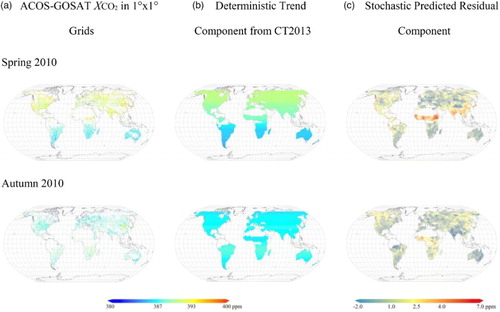Figures & data
Figure 1. Example of the spatial distribution and variation of the used ACOS-GOSAT XCO2 retrievals for four months of (a) July 2009, (b) October 2009, (c) January 2010 and (d) April 2010 over global land.
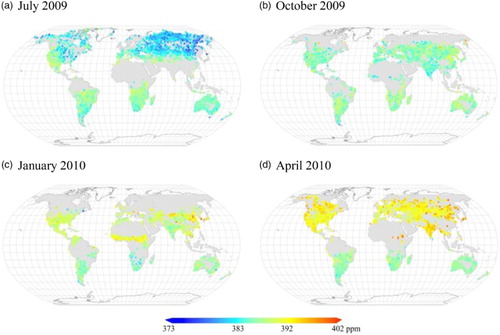
Figure 2. (a) Global spatial distribution density of the used ACOS-GOSAT XCO2 retrievals (after filtering) from June 2009 to May 2013 in terms of available data number in grids of 5°longitude by 5°latitude and (b) temporal variation of available ACOS-GOSAT retrievals (after filtering) in each 3-day interval. The dashed rectangle area in (a) from 5 to 15°N and 20°W to 40°E covers the tropical region in central Africa, which will be used in Sections 4.5 and 4.6.

Table 1. Annual statistics for the ACOS-GOSAT v3.3 XCO2 global land data used in this study after filtering and bias-correction.
Figure 3. Global distribution of the 16 TCCON sites used for the comparison with the mapping dataset, and the global land study area for mapping in gray.

Figure 4. NOAA Earth System Research Laboratory (ESRL) annual mean global CO2 growth rate for the year 2000 to 2013, published in ESRL-NOAA webpage: http://www.esrl.noaa.gov/gmd/ccgg/trends/global.html.
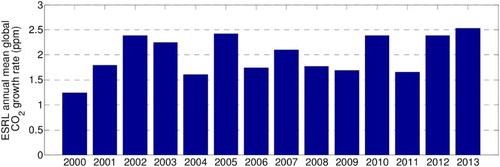
Figure 5. Workflow chart for the spatio-temporal mapping process and the evaluation of the mapping data products in this study. The input datasets are displayed in bold and the numbers in the boxes denote the section numbers in the manuscript.
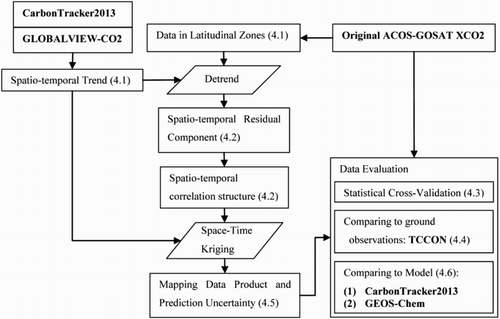
Figure 6. (a) Overview of the global spatio-temporal distribution of XCO2 as a function of latitude and time from original ACOS-GOSAT data aggregated with a grid resolution of 5° in latitude and one month in time and (b) the corresponding deterministic spatio-temporal trend calculated from model simulation of CarbonTracker CT2013 XCO2 data with a grid resolution of 2° in latitude and one time-unit (3-day) in time.

Table 2. Zonal statistics for the 11 bands, including the central latitude of each 10° latitude zone, the number of available data, the median and standard deviation of the ACOS-GOSAT XCO2 data from June 2009 to May 2013 in the corresponding zone, the parameters of the spatio-temporal variogram model of the ACOS-GOSAT data, and the corresponding nugget/sill ratios in space and time, respectively.
Figure 7. For each latitude zone, the left plot shows the spatio-temporal empirical variogram of the ACOS-GOSAT XCO2 residual data after the spatio-temporal trend is excluded, and the right plot shows its fitted variogram model using the product-sum model in Equation (4).
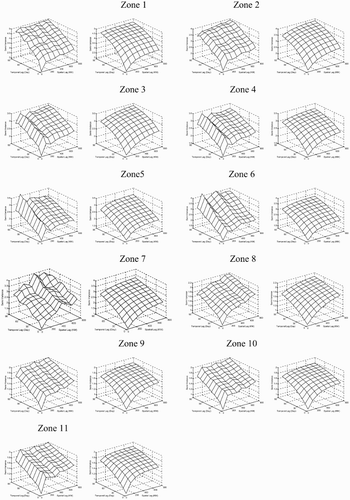
Table 3. Summary statistics for the developed spatio-temporal method and spatial-only method from global land cross-validation based on the Monte Carlo sampling technique, including correlation coefficient (r2), MAPE, RMSE, and percentage of prediction error within 1 ppm (PPE1) for the global mapping approach.
Figure 8. Temporal variation comparison for the 16 TCCON sites. As shown in these panels, the original ACOS-GOSAT XCO2 retrievals within 500 km of the TCCON site are in gray dots, the corresponding medians are in black dots when at least three data points are available within the time-unit. The TCCON data, smoothed by applying the ACOS-GOSAT averaging kernel, are indicated by blue circles. The data are chosen using coincidence criteria of within ±2 hours of GOSAT overpass time, and a 3-day (one time-unit) median is calculated for the comparison if the number of data points within the time-unit is at least 3. The predicted TCCON site XCO2 time series using the global land mapping approach are indicated by the red line.
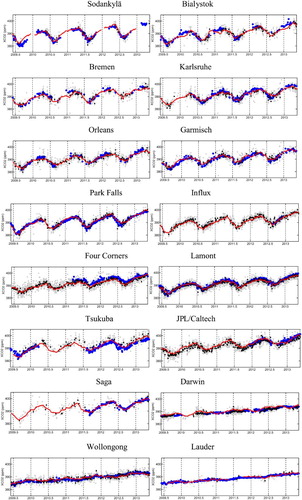
Figure 9. Statistics of comparison between the geostatistical mapping results and the TCCON data (smoothed by applying the ACOS-GOSAT averaging kernel), and between the ACOS-GOSAT 3-day median XCO2 data and TCCON data, hereafter referred to as Mapping-TCCON and ACOS-TCCON, respectively. The statistics are also shown in . The top panel shows the comparison of XCO2 biases between Mapping-TCCON and ACOS-TCCON, while the down panel shows the comparison of numbers of coincident data pairs between them.
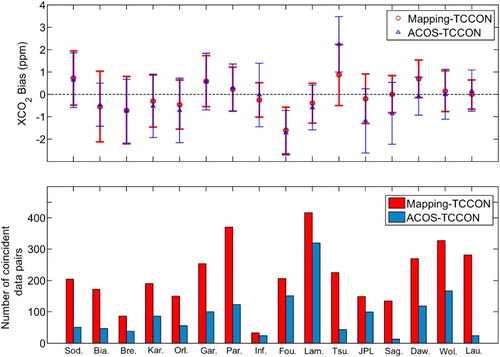
Table 4. Statistics of comparison between the geostatistical mapping results and the TCCON data (smoothed by applying the ACOS-GOSAT averaging kernel), and between the ACOS-GOSAT 3-day median XCO2 data and TCCON data, hereafter referred to as Mapping-TCCON and ACOS-TCCON, respectively.
Figure 10. Spatial distribution of seasonal mean XCO2 from global land mapping for three years of 2010 in panel (a), 2011 in panel (b) and 2012 in panel (c). Four images in each panel corresponds to spring, summer, autumn and winter from left to right, respectively. These global land mapping seasonally averaged results in 1° by 1° grid are obtained by calculating the seasonal mean from the geostatistical mapping results when at least one data is available for each of the three months in that season. As usual, the season spring includes three months of March, April and May, summer includes June, July and August, autumn includes September, October and November, and winter includes December, next year January and February.
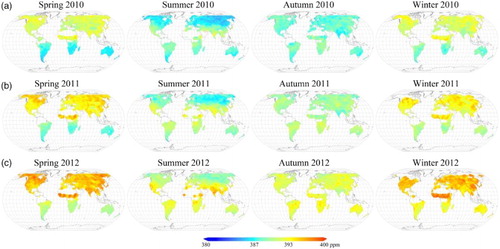
Figure 11. Kriging standard deviations of prediction, a measurement of prediction uncertainty. (a) Spatial distribution, which is obtained by averaging the kriging standard deviations over all time-units in the global land. (b) Temporal distribution for the 11 zones, which are averaged for each time-unit of each zone from June 2009 to May 2013. For each time-unit and each zone, the averages are calculated only when more than 50% of the data are available.

Figure 12. Overview of the global spatio-temporal distribution of XCO2 as a function of latitude and time, from (a) global land mapping dataset with a grid resolution of 1° in latitude and one time-unit in time, (b) original ACOS-GOSAT data with a grid resolution of 5° in latitude and one month in time, and model simulations from both (c) CarbonTracker CT2013 data with a grid resolution of 2° in latitude and one time-unit in time and (d) GEOS-Chem data in 2010 with a grid resolution of 4° in latitude and one time-unit in time, and an overview of the differences of global spatio-temporal distribution of XCO2 between (e) global land mapping dataset and CarbonTracker2013 data, (f) global land mapping dataset and GEOS-Chem data, (g) original ACOS-GOSAT data and CarbonTracker CT2013 data, and (h) original ACOS-GOSAT data and GEOS-Chem data.
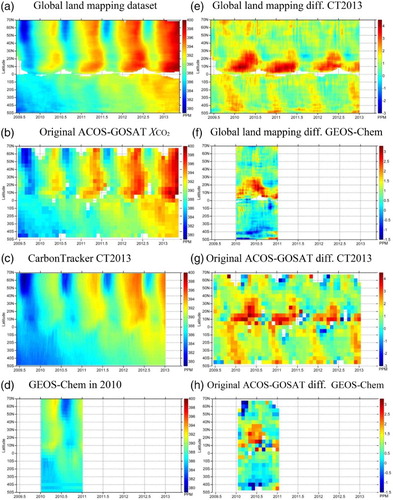
Figure 13. The panel shows the XCO2 time series in central Africa within 5°N to 15°N in latitude and 20°W to 40°E in longitude. The original ACOS-GOSAT data indicated by gray dots and its mean in black dots calculated when at least three data points are available within the time-unit. The mapping dataset mean is indicated by the blue line, CarbonTracker CT2013 data mean by the red line and GEOS-Chem data mean by the green line.


